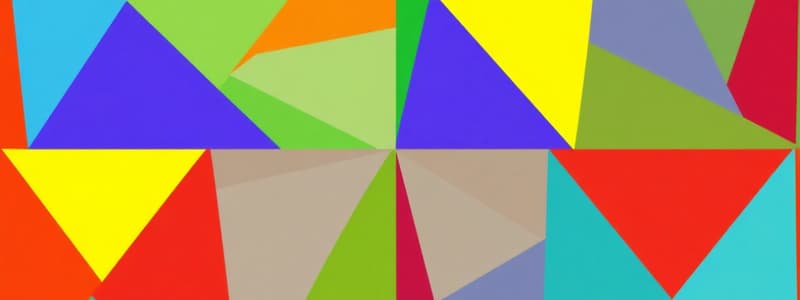Podcast
Questions and Answers
Which of the following is NOT a property of parallelograms?
Which of the following is NOT a property of parallelograms?
- Opposite angles are congruent.
- Diagonals bisect each other.
- Opposite sides are parallel.
- All angles are right angles. (correct)
Consecutive angles in a parallelogram are supplementary (add up to 180 degrees).
Consecutive angles in a parallelogram are supplementary (add up to 180 degrees).
True (A)
What is the name given to the line segment that connects the midpoints of two sides of a triangle?
What is the name given to the line segment that connects the midpoints of two sides of a triangle?
Midsegment
The diagonals of a parallelogram ______ each other.
The diagonals of a parallelogram ______ each other.
Match the following properties to the correct quadrilateral:
Match the following properties to the correct quadrilateral:
Which of the following statements about parallelograms is TRUE?
Which of the following statements about parallelograms is TRUE?
A diagonal divides a parallelogram into two congruent triangles.
A diagonal divides a parallelogram into two congruent triangles.
Describe the relationship between the opposite angles in a parallelogram.
Describe the relationship between the opposite angles in a parallelogram.
What is the formula for calculating the area of a trapezoid?
What is the formula for calculating the area of a trapezoid?
In an isosceles trapezoid, the two ______ sides are equal in length.
In an isosceles trapezoid, the two ______ sides are equal in length.
The median of a trapezoid is parallel to the bases and its length is equal to the average of the lengths of the two bases.
The median of a trapezoid is parallel to the bases and its length is equal to the average of the lengths of the two bases.
What is the relationship between the diagonals of a kite?
What is the relationship between the diagonals of a kite?
Match the following terms with their corresponding descriptions:
Match the following terms with their corresponding descriptions:
In a kite, the non-vertex angles are [blank].
In a kite, the non-vertex angles are [blank].
Which of the following statements is NOT true about a kite?
Which of the following statements is NOT true about a kite?
The area of a kite is calculated as half the product of its ______ lengths.
The area of a kite is calculated as half the product of its ______ lengths.
What is the defining property of the diagonals of a kite?
What is the defining property of the diagonals of a kite?
The area of a kite can be calculated by taking half the product of its diagonal lengths.
The area of a kite can be calculated by taking half the product of its diagonal lengths.
What type of angles do the diagonals of a kite bisect?
What type of angles do the diagonals of a kite bisect?
In a kite, the diagonal connecting the vertices of the vertex angles serves as the __________ of the other diagonal.
In a kite, the diagonal connecting the vertices of the vertex angles serves as the __________ of the other diagonal.
Match the properties with their corresponding statements about kites:
Match the properties with their corresponding statements about kites:
Flashcards
Kite Diagonals Theorem
Kite Diagonals Theorem
The diagonals of a kite are perpendicular to each other.
Kite Diagonal Bisector Theorem
Kite Diagonal Bisector Theorem
The diagonal connecting the vertex angles bisects the other diagonal.
Kite Angle Bisector Theorem
Kite Angle Bisector Theorem
The vertex angles of a kite are bisected by its diagonal.
Congruent Diagonals in Isosceles Trapezoids
Congruent Diagonals in Isosceles Trapezoids
Signup and view all the flashcards
Area of a Kite
Area of a Kite
Signup and view all the flashcards
Trapezoid
Trapezoid
Signup and view all the flashcards
Bases of a trapezoid
Bases of a trapezoid
Signup and view all the flashcards
Legs of a trapezoid
Legs of a trapezoid
Signup and view all the flashcards
Isosceles trapezoid
Isosceles trapezoid
Signup and view all the flashcards
Midline Theorem
Midline Theorem
Signup and view all the flashcards
Midsegment of a trapezoid
Midsegment of a trapezoid
Signup and view all the flashcards
Parallelogram properties
Parallelogram properties
Signup and view all the flashcards
Sum of angles in a parallelogram
Sum of angles in a parallelogram
Signup and view all the flashcards
Area of a Trapezoid
Area of a Trapezoid
Signup and view all the flashcards
Median of a Trapezoid
Median of a Trapezoid
Signup and view all the flashcards
Kite Area Formula
Kite Area Formula
Signup and view all the flashcards
Kite Diagonal Intersection
Kite Diagonal Intersection
Signup and view all the flashcards
Kite Angles Theorem
Kite Angles Theorem
Signup and view all the flashcards
Trapezoid Bases Relationship
Trapezoid Bases Relationship
Signup and view all the flashcards
Height of a Trapezoid
Height of a Trapezoid
Signup and view all the flashcards
Study Notes
Trapezoid and Kites
- Trapezoids and kites are quadrilaterals that are not parallelograms
- A trapezoid is a quadrilateral with exactly one pair of parallel sides
- The parallel sides of a trapezoid are called bases
- The non-parallel sides are called legs
- Base angles are the angles that share a common base
- An isosceles trapezoid is a trapezoid with legs of equal length
- The diagonals of an isosceles trapezoid are congruent
- A kite is a quadrilateral with two pairs of adjacent congruent sides
- The diagonals of a kite are perpendicular
- One diagonal of a kite bisects the other diagonal
- The non-vertex angles of a kite are congruent
- The area of a kite is one-half the product of its diagonal lengths
Learning Objectives
- Applying the Midline Theorem to solve problems involving triangles
- Proving theorems of trapezoids and kites
- Solving problems involving parallelograms, trapezoids, and kites
Review
- All quadrilaterals have four sides
- Squares are a specific type of rectangle
- Parallelograms have two sets of parallel sides
- Rectangles have four right angles
- Squares have four equal sides
- Opposite sides of a parallelogram are equal in length
- Consecutive angles in a parallelogram are supplementary (sum to 180 degrees)
- Opposite angles in a parallelogram are congruent
- Diagonals of a parallelogram bisect each other
- A diagonal divides a parallelogram into two congruent triangles
Triangle Midsegment Theorem
- A triangle's midsegment is half the length of the third side and is parallel to the third side
- Connecting the midpoints of two sides of a triangle creates the midsegment
Trapezoid Midsegment Theorem
- A trapezoid midsegment is parallel to its bases and is equal to half the sum of the lengths of the bases
Example Problems
- Various example problems are provided demonstrating how to apply theorems and solve for unknown values (e.g., lengths of sides, angles, areas) in trapezoids, kites, and triangles involving midsegments. Specific details from these examples are included in the subsections below.
Theorems on Kite
- Kite area is calculated as one-half the product of the lengths of its diagonals
- The intersection of the diagonals of a kite forms a 90-degree angle
- One diagonal bisects the other diagonal
Examples Problems (specific calculations and information for kite and trapezoid)
- Includes worked examples demonstrating the applications of the stated theorems (e.g., finding lengths of midline, sides, and areas of different shapes).
- Specific examples of applying the definitions outlined above for trapezoids and kites
Studying That Suits You
Use AI to generate personalized quizzes and flashcards to suit your learning preferences.




